Classic Games Emulation | News | Systems | Emulation | Emulators | Games | Links
More Atari 2600 Games
Boxing
Activision
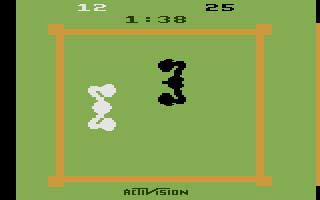
Boxing is one of my favorite Atari games, and it is one of the few Atari sports games that I ever play. Boxing's unique overhead perspective causes the game to simultaneously become a vigorous joystick exercise, and practice in footwork, something where most boxing games on any system fall short.
California Games
Epyx, 1988
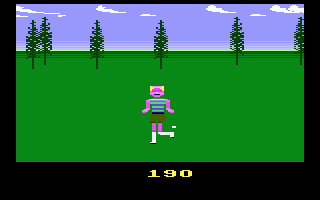
(See The Epyx Games Series for information on the Commodore 64 versions of this game).
In California Games, as many as eight players can compete in four different events - Halfpipe (i.e. skate boarding), Foot Bag, Surfing, and BMX - in an attempt to get the highest scores and beat their competitors.
California Games has decent graphics (though the BMX event is rather weak in this respect, and the multicolored water of the Surfing event is a little odd), and the sound (especially the music) is generaly acknowledged to be some of the best ever on the 2600. California Games is also noticeable for supporting as many as eight players, which is rather uncommon outside of the Epyx "Games" series.
Gameplay is relatively simple, but only moderately interesting, there being only so many different combinations of moves possible in any given event. BMX is probably the most fun, followed by Foot Bag. Halfpipe is fairly good also, but Surfing is not so interesting (and inferior to Surfing in other versions of the game for other platforms), as it consists mostly of going around in circles on a wave. Replay value, however, is high as a result of the I-just-have-to-beat-my-last-high-score syndrome. This, of course, is common in Atari games, but here it is exacerbated by the low time limits on the events (1.5 minutes, generally).
California Games is a solid game for the Atari, but primarily interesting as an alternative port of a game more popular on other systems, and as having good graphics and some of the best sound on an Atari game (common criteria for a PC game, but a little odd to apply to an Atari game...).
(California Games was originally released on several platforms. The Atari 2600 version was least like the others. The Halfpipe was fairly close to the Halfpipe in other versions. Foot Bag looks quite similar, though it is not scored by special stunts as in the other versions. Surfing is somewhat similar, but looks rather different. And BMX looks absolutely nothing like any other versions' BMX event. I don't really think that gameplay on the Atari version is as good as on other systems either, given its more limited nature.)
Okie Dokie
Bob Colbert (Retroware), 1996
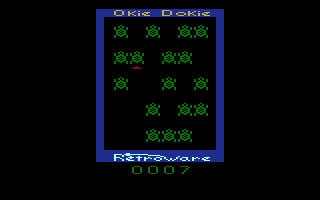
Okie Dokie is a simple puzzle game in which the player tries to clear the board by inverting cross-shaped areas.
Okie Dokie was the first new Atari 2600 game in many years, with the exception of Edtris, a Tetris-clone released a few years ago. Okie Dokie was also the first Atari 2600 game to be released (for free, no less) over the Internet.
Okie Dokie looks good, and it's fun to play, even if the game's concept is not entirely original. If only someone would build a hand-held Atari, it would probably be even more fun.
Oystron
Piero Cavino, 1997
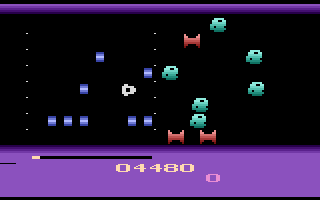
In Oystron, the player must collect perals out of "space oysters," while dodging all kinds of enemies. By collecting perals and depositing them in a line in the grid on the left side of the screen, the player receives bombs, which he can use to destroy the Oystron that appears at the end of every level.
Oystron, which came about a year after Okie-Doke, was one of the first new games for the Atari. It started out as a programming exercise, but quickly grew in to a full-fledged game. And it was surprisingly good.
The graphics are detailed and colorful, and they have a "classic" feel to them. The sound is fairly good. The wide variety of enemies is another plus. But, most of all, Oystron has simple, but original, gameplay. It's also insidiously difficult, but then that is probably another positive feature.
Pole Position
Atari, 1983

Pole Position was originally an arcade game eventually ported to several platforms. While the Commodore 64 version is better known and more fun to play, this version is not bad either. The graphics are quite good for an Atari 2600 game, and they closely resemble the real graphics (most arcade ports on the Atari looked nothing like the original). What hurts gameplay is the control method. Unlike other versions of the game, the car automatically accelerates, so that the only input necessary from the player is shifting (there are only two gears) and steering, which, like all Pole Position version, is rather sluggish. The automatic acceleration makes the game in some ways too easy and less interesting. Another problem is that one can not tell where cars in front are on the road; as the player approaches the cars they have a tendency to bounce left and right until the last secnd, when it may be too late to respond. However, the game is still pretty fun, and it looks good.
Seaquest
Activision

Seaquest (which has nothing to do with the later television series of the same name) is a rather simple game. The player must rescue six divers at a time with his sub, while avoiding deadly fish and enemy submarines and watching the oxygen level. That's all; avoid or destroy bad guys, catch the divers. Much of the fun of Seaquest is its simplicity. I like to play for a few minutes at a time in between other tasks just to keep my reflexes up. Also, the graphics in Seaquest are quite good, building well the underwater environment. Seaquest is hardly innovative, but it does fairly well even in its confined role.
Space War
Atari
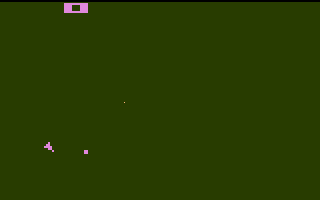
Space War has several variations, but all of them center around the game's physics engine.. This is one of the few games that has attempted to approximate actual zero gravity maneuvering (although, indeed, many more early games had this feature than modern games, and even games like Asteroids had a similar feature). For example, in order to stop the ship, the player must turn the ship opposite te direction of motion and fire the engines just enough to slow to a stop without reversing direction.
Most variations involve two players trying to get the most kills. Some (and probably the most interesting) involve docking with a moving object.
Space War is somewhat unique, and for that I definitely have to give it a place here. The game's engine makes for very interesting gameplay. Unfortuantely, the graphics a very low resolution, but that is not enough to spoil a game which is this fun to play.
Star Wars: The Empire Strikes Back
Parker Bros.
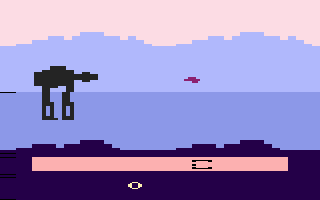
In Star Wars: The Empire Strikes Back, the player pilots a snowspeeder, trying to defend the evacuating Hoth base as long as possible from the AT-AT walkers.
This game is one of my favorite Atari 2600 games. The gameplay is lively and fun, as always, and the graphics are good. The cool colors give the proper icy feel of the planet Hoth, and the animated walkers look quite good for Atari sprites. The music, the Star Wars theme plays every few minutes while the speeder becomes temporarily invincible, is fairly good too. With fast action and the best atmosphere of almost any game on the Atari, this game is one of my personal favorites to play right behind Asteroids and Seaquest.
Vanguard
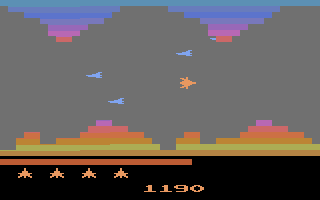
In Vanguard, the player must fly his ship through underground tunnels, fighting against all kinds of alien creatures.
Vanguard had some features that, while common on later console and arcade games, were unusual for an Atari game. It had a continue feature (the player could continue from any point with a reset score if he or she died), it had a boss at the end of the game, and it even had both horizontally and vertically scrolling segments. Vanguard had decent (even if perhaps not singularly impressive) graphics and music. Its gameplay is not too bad, though not particularly interesting. On the whole, Vanguard is an fun and interesting game. (Vanguard eventually even gave its name to a genre; many side-scrolling ships-in-underground-tunnel games are called Vanguard-style.)
About CGE (including contact information)
Created June 10, 1998. Last modified September 28, 1998.